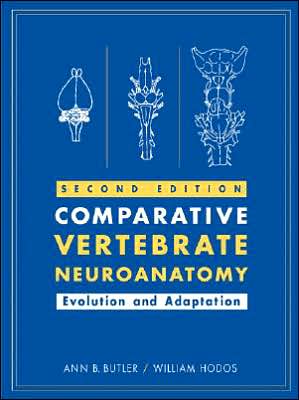Comparative Vertebrate Neuroanatomy: Evolution and Adaptation
Comparative Vertebrate Neuroanatomy\ Evolution and Adaptation\ Second Edition\ Ann B. Butler and William Hodos\ The Second Edition of this landmark text presents a broad survey of comparative vertebrate neuroanatomy at the introductory level, representing a unique contribution to the field of evolutionary neurobiology. It has been extensively revised and updated, with substantially improved figures and diagrams that are used generously throughout the text. Through analysis of the variation in...
Search in google:
This upper-level undergraduate and graduate text presents a broad survey of comparative vertebrate neuroanatomy through a substantial number of updated illustrations and material drawn from the most current research. The text covers the evolution and the organization of the central nervous system, including neurons and sensory preceptors, the central nervous system, phylogeny and diversity in brain organization, and theories of brain evolution and its effects on behavior and intelligence. Topics on the spinal cord and hindbrain include the segmental organization of the head, brain and cranial nerves, the reticular formation, and the cerebellum, with examinations of the motor and sensory nerves of the cranial brainstorm, those describing the midbrain include descriptions of the tegmentum, tori and optic tectum. The forebrain is covered comprehensively, including analyses of the structures of the diencephalon and telencephalon. Annotation ©2005 Book News, Inc., Portland, OR Manuel Dujovny This book is a review of the evolution and adaptation of the CNS of animals. The book intends to analyze the relationship and evolution of the CNS in vertebrates. The audience for this book is composed of neuroscientists and neuroanatomists as well as neurophysiologists, neurologists, and veterinarians. The book provides an excellent presentation and illustrations. This excellently formatted book incorporates new approaches to comparative analysis: (1) organization degree of evolution of the CNS; (2) a special analysis of the evolution of the thalamus and the forebrain; (3) evolution and embryology analysis. Comparative vertebrate neuroanatomy and the correlation between mammals and nonmammals is one of the outstanding achievements of this book. The adaptation and evolution of the CNS of different species is well demonstrated. I highly recommend this book for neuroscientists, neuroanatomists, neurophysicists, and clinical neurologists.
1Evolution and variation32Neurons and sensory receptors193The vertebrate central nervous system494Vertebrate phylogeny and diversity in brain organization735Evolution and adaptation of the brain, behavior, and intelligence936Theories of brain evolution1137Overview of spinal cord and hindbrain1278The spinal cord1399Segmental organization of the head, brain, and cranial nerves15710Functional organization of the cranial nerves17311Sensory cranial nerves of the brainstem18312Motor cranial nerves20513The reticular formation22114The cerebellum24115Overview of the midbrain26716Isthmus27517Tegmentum and tori28918Optic tectum31119Overview of the forebrain34320Pretectum, accessory optic system, and migrated posterior tuberculum37321Epithalamus40722Dorsal thalamus41723The visceral brain : the hypothalamus and the autonomic nervous system44524Basal telencephalon47125Nonlimbic pallium49526Visual forebrain in amniotes52327Somatosensory and motor forebrain in amniotes54728Auditory and vocal forebrain in amniotes57129Terminal nerve and olfactory forebrain59330Limbic telencephalon61131Evolution of brains : a Bilaterian view637
\ From the Publisher"As a textbook for advanced courses and reference work for anyone whose interests touch on vertebrate neuroanatomy...it is a uniquely valuable single-volume survey." (The Quarterly Review of Biology, June 2006)\ "...well written and can be a valuable reading material for basic understanding of the brain and its adaptation." (American Association of Anatomists Newsletter, March 2006)\ \ \ \ \ \ Manuel DujovnyThis book is a review of the evolution and adaptation of the CNS of animals. The book intends to analyze the relationship and evolution of the CNS in vertebrates. The audience for this book is composed of neuroscientists and neuroanatomists as well as neurophysiologists, neurologists, and veterinarians. The book provides an excellent presentation and illustrations. This excellently formatted book incorporates new approaches to comparative analysis: (1) organization degree of evolution of the CNS; (2) a special analysis of the evolution of the thalamus and the forebrain; (3) evolution and embryology analysis. Comparative vertebrate neuroanatomy and the correlation between mammals and nonmammals is one of the outstanding achievements of this book. The adaptation and evolution of the CNS of different species is well demonstrated. I highly recommend this book for neuroscientists, neuroanatomists, neurophysicists, and clinical neurologists.\ \ \ BooknewsA text/reference for undergraduate and graduate students, physicians, and neuroscientists, illustrating the ongoing relationship between the structure and function of vertebrates. Presuming little prior knowledge of anatomy or biology beyond the college level, it presents a systematic account of the functions of brain systems in vertebrates and their relationship to behavior, adaptation, and survival; new material on the embryology and functional organization of the cranial nerves; and a comparison of vertebrate brains that reveals how similar they are in some ways, and how different in others. Includes numerous drawn figures and diagrams. Annotation c. Book News, Inc., Portland, OR (booknews.com)\ \ \ \ \ From The CriticsReviewer: Manuel Dujovny, MD(Wayne State University School of Medicine)\ Description: This book is a review of the evolution and adaptation of the CNS of animals.\ Purpose: The book intends to analyze the relationship and evolution of the CNS in vertebrates.\ Audience: The audience for this book is composed of neuroscientists and neuroanatomists as well as neurophysiologists, neurologists, and veterinarians.\ Features: The book provides an excellent presentation and illustrations.\ Assessment: This excellently formatted book incorporates new approaches to comparative analysis: (1) organization degree of evolution of the CNS; (2) a special analysis of the evolution of the thalamus and the forebrain; (3) evolution and embryology analysis. Comparative vertebrate neuroanatomy and the correlation between mammals and nonmammals is one of the outstanding achievements of this book. The adaptation and evolution of the CNS of different species is well demonstrated. I highly recommend this book for neuroscientists, neuroanatomists, neurophysicists, and clinical neurologists.\ \ \ \ \ 3 Stars from Doody\ \








